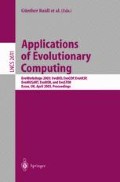Abstract
A GP-automaton evolves motif sequences for its states; it moves the point of motif application at transition time using an integer that is stored and evolved in the transition; and it combines motif matches via logical functions that it also stores and evolves in each transition. This scheme learns to predict promoters in human genome. The experiments reported use 5-fold cross validation.
Access this chapter
Tax calculation will be finalised at checkout
Purchases are for personal use only
Preview
Unable to display preview. Download preview PDF.
References
Ashlock, D. (1997). GP-Automata for dividing the dollar. In Koza et. al. (Eds) Genetic Programming: Proceedings of the Second Annual Conference, 18–26, Stanford University.
Benson, K. A. (2000). Evolving Finite State Machines with Embedded Genetic Programming for Automatic Target Detection within SAR Imagery In Proceedings of the Congress on Evolutionary Computation, 1543–1549, La Jolla, San Diego, USA.
Benson, K. A. (2000). Performing Automatic Target Detection with evolvable finite state automata. In Journal of Image and Vision Computing, Volume 20, Issue 9–10, Elsevier.
Cattaneo E., Rigamonti D., Zuccato C. The Enigma of Huntington’s Disease. Scientific American, December 2002.
Hannenhalli S. and Levy S. (2001). Promoter prediction in the human genome. In Proceedings of the 9th International Conference on Intelligent Systems for Molecular Biology. Copenhagen, Denmark, July 21-25, 2001, Bioinformatics, Vol 17, Supplement 1, pp. S90–S96. ISSN: 1367-4803.
John R. Koza (1999). Genetic Programming III: Darwinian Invention and Problem Solving, MIT Press.
Benjamin Lewin (2000). Genes VII, Oxford University Press.
Orphanides, G., Lagrange, T., Reinberg, D.. The general transcription factors of RNA polymerase II. Genes. Dev., vol. 10, 2657–2683, 1996.
Pedersen, A. G., Baldi, P., Chauvin, Y., Brunak, S. The biology of eukaryotic promoter prediction-a review. Computers and Chemistry, vol. 23, 191–207, 1999.
Author information
Authors and Affiliations
Editor information
Editors and Affiliations
Rights and permissions
Copyright information
© 2003 Springer-Verlag Berlin Heidelberg
About this paper
Cite this paper
Howard, D., Benson, K. (2003). Promoter Prediction with a GP-Automaton. In: Cagnoni, S., et al. Applications of Evolutionary Computing. EvoWorkshops 2003. Lecture Notes in Computer Science, vol 2611. Springer, Berlin, Heidelberg. https://doi.org/10.1007/3-540-36605-9_5
Download citation
DOI: https://doi.org/10.1007/3-540-36605-9_5
Published:
Publisher Name: Springer, Berlin, Heidelberg
Print ISBN: 978-3-540-00976-4
Online ISBN: 978-3-540-36605-8
eBook Packages: Springer Book Archive

